ASUS G74SX: Noteworthy Updates to ASUS' G7 Series
by Jarred Walton on October 6, 2011 12:00 AM ESTApplication Performance: Add an SSD for Improved Performance
The last-gen G73SW would offer nearly identical performance in our application suite were it not for one thing: the Intel 320 Series SSD in the G74SX. Keep the same processor, improve GPU performance a bit, and add in an SSD and what you get is markedly faster boot and application start times and a smoother overall experience. We’ve mentioned how much Futuremark’s PCMark suites skew towards SSDs, but there’s something to be said for what an SSD can provide. I still feel like it should be more like a 30% improvement in application scores—and you really mostly notice it when launching applications or booting, particularly if you launch multiple applications at once or have half a dozen startup programs. We’ll start with the PCMark suites before moving into CPU-limited testing.
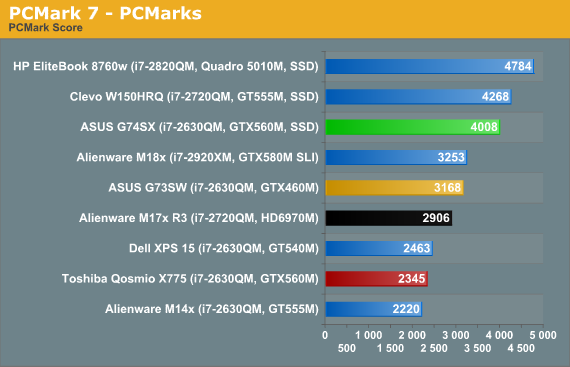
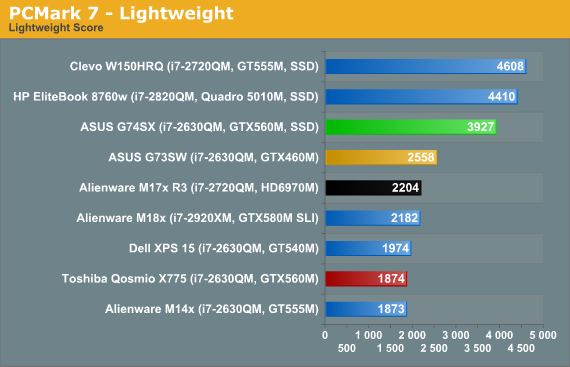
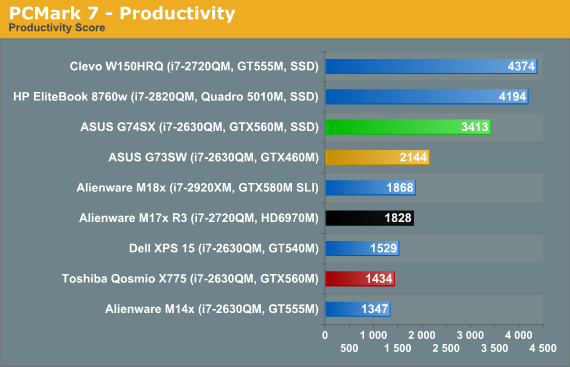
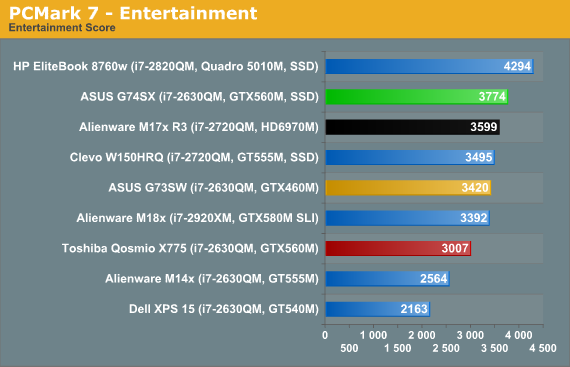
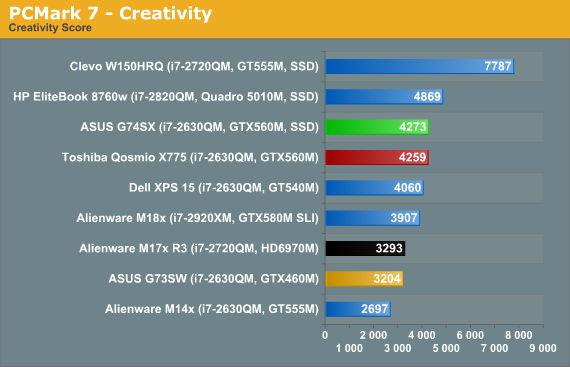

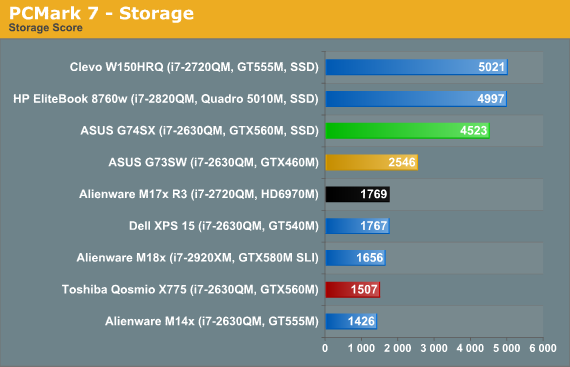

So I just said that I felt the overall benefit to general performance from an SSD should be around 30%, and for the overall PCMark 7 suite that’s exactly what we get: the G74SX ends up 27% faster than the G73SW. Elsewhere, the G74SX is anywhere from equal to its predecessor (the Computation score), to 10% faster (Entertainment), to around 30% faster (Creativity), or as much as 50 to 80% faster (Lightweight, Productivity, and Storage). Turning to the older PCMark Vantage, the G74SX tops the G73SW by 42%.
Moving to a slightly different notebook, however, we can see the problem: the G74SX is 38% faster than the Alienware M17x R3 in the overall PCMark 7 suite, even though the Alienware has a faster i7-2720QM processor, and it’s 155% faster in the storage benchmark—and the M17x is sporting RAID 0 750GB HDDs. ASUS has somehow optimized storage performance so that PCMark 7 really favors their notebooks, and the SSD boosts their score by an appropriate ~30%, but the G73SW already outperforms similarly equipped laptops (e.g. the Dell XPS 15) by 28%, likely thanks to storage optimizations.
I can’t really say that any of the individual scores are without merit, but I can say that you shouldn’t expect a 50% boost in gaming performance from adding an SSD—even if you happen to have enough free space on our SSD to hold the games you play. Similarly, video encoding performance and other computationally intensive tasks are still going to hinge on raw CPU speed, and PCMark’s Computation result reflects this (assuming you’re not using Quick Sync, which we’re not on most of these notebooks, the Qosmio, XPS 15, and W150HRQ being the exceptions). Here are the results from the remainder of our application suite, along with a few 3DMark scores, to round out our general performance overview.
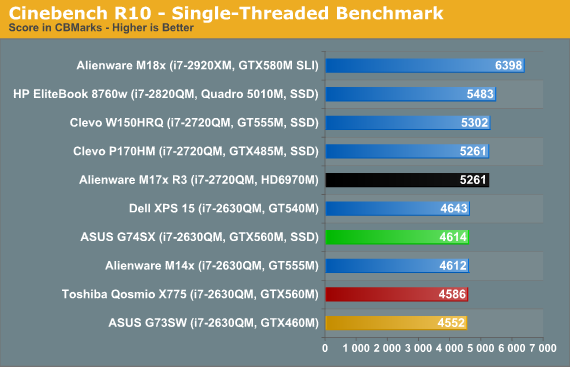
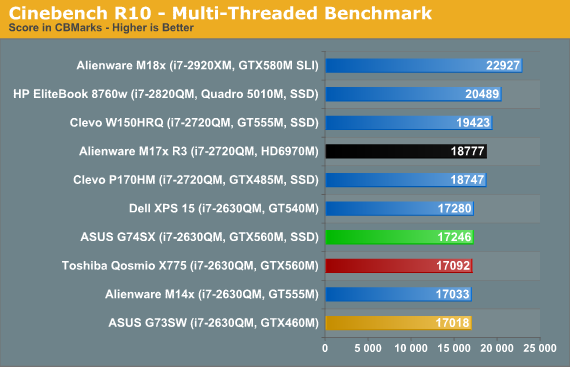
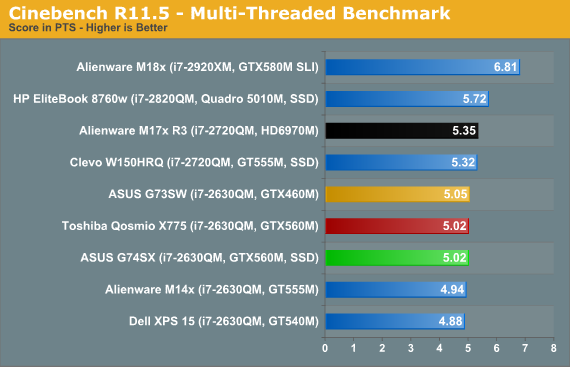
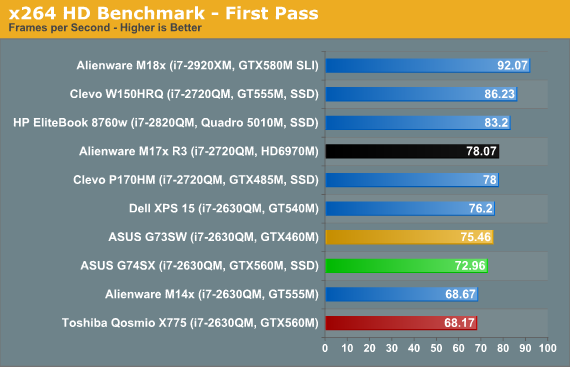
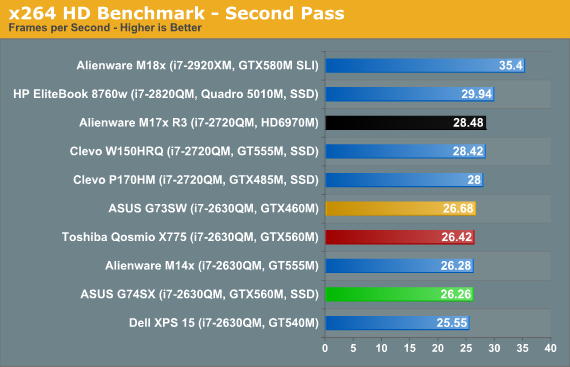

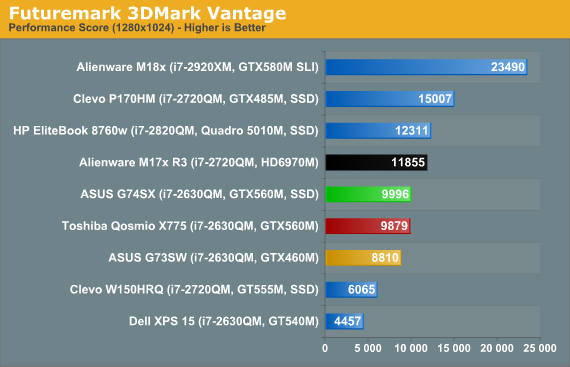
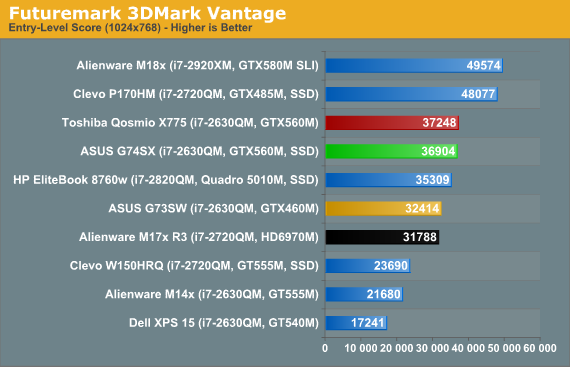
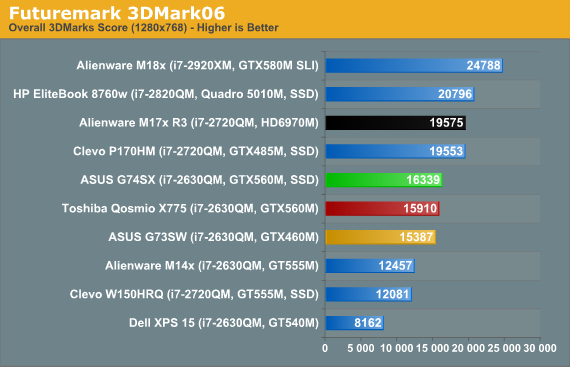
The i7-2630QM is a well-known quantity, and the results fall out right about where we’d expect. There’s some minor variation in performance in the x264 encode first pass, but nothing to worry about. 3DMark gives us our first glimpse of the graphics upgrade the GTX 560M brings to bear, and the results range from 22% faster than the G73SW (3DMark 11) to only 6% faster (3DMark06). We’re also testing with a newer driver release on the G74SX, which may explain the score discrepancy between the ASUS and the Toshiba Qosmio. Optimus may also be a factor, but more likely it’s just drivers. Let’s hit the gaming results next for a full look at graphics performance.










44 Comments
View All Comments
plonkplink - Thursday, October 6, 2011 - link
I'll just skip this review since:1. it has a squinty letterbox screen (16:9).
2. it's an octodecillion times uglier than the saxxy Toshiba Qosmio.
3. Just as someone said: "beep blueray;that is all.". :)
Dustin Sklavos - Thursday, October 6, 2011 - link
2 and 3 are reasonable enough...1, though. Yeah...good luck with that. The industry made the shift. None of us are happy about it, but we can either sit in the corner and sulk about the lost 120 pixels of vertical real estate or be happy that mobile graphics are fast enough to drive the rest of it.
JojoKracko - Thursday, October 6, 2011 - link
I have to agree with 1. By going to a 17 inch laptop, you've already decided to accept a larger size / heavier / more expensive laptop so that negates all of the manufacturer's flimsy excuses for using a 16x9 display over a 16x10 version. Total BS IMHO how the industry got away with screwing everyone with this aspect ratio change. 16x10 is better for every single use on your computer - except one - watching movies. And really, how many of you would prefer to watch a movie on your laptop instead of on your widescreen TV?2. I personally prefer the G74. Call me crazy. Better textures.
3. As I would watch movies on my TV, I agree. Beep Blueray!
I'd add 4. Beep more than 8 GB of ram on laptops and more than 1.5 GB on the video cards in general. Useless, wasteful marketing gimmicks. Lower the price by the same amount instead. It is already crazy how fast a 2 grand laptop loses its value.
5. Matte AR Screen for fricks sake ASUS!!!!!
6. MATTE SCREEN - it is worth repeating until they realize they could take ALL of MSI's business with this one change.
seapeople - Friday, October 7, 2011 - link
Stop saying this.1920x1200 is better than 1920x1080 because it has more pixels, not because of the aspect ratio.
I actually prefer more screen width than height... I always run into problems with width when I'm trying to look at multiple applications on the screen at once rather than height.
If you're really going to argue that it's the aspect ratio, then tell me what you would like better: 1600x900 or 1440x900?
erple2 - Sunday, October 9, 2011 - link
Until applications become more horizontally focused, the more vertical pixels become important.It's not that I prefer 1440x900 over 1600x900, it's for a given number of horizontal pixels, I'd MUCH rather have more vertical pixels - so I'd prefer 1600x1000 over 1600x900 every time.
As long as the menubars, tabs, close buttons etc are all aligned vertically, I'll still say that I want more vertical pixels for a given horizontal pixel count.
I wouldn't mind having a 2133x1200 res screen (16x9 with 1200 vertical pixels), but nobody makes them.
Even on my 1080p laptop, I feel as though it's vertically cramped. Then again, I'm used to using 1920x1200 screens on my desktop for work and play.
Wolfpup - Friday, October 7, 2011 - link
16:9 is today's normal aspect ratio, and it's not "squinty", the resolution and screen size work pretty well for a notebook."Ugly" is subjective, but I like the G74's utilitarianness. I find Toshiba and Dell's systems much uglier, though that's bottom on my list for why I buy a system regardless.
And I have no idea what "beep blueray" means. At first I thought you thought this didn't have it, which it does. Now I'm thinking you DON'T want it for some unknown reason...well, you don't have to use it, or can buy a cheaper G74 model without it.
JojoKracko - Tuesday, October 11, 2011 - link
Beep Bluray just means that it is unnecessary for most of us. Especially the versions with the bluray burner. Realistically, how many buyers of the G74 do so because it has a bluray burner? Half of 1 percent? If that? It is a useless marketing gimmick. Just like moving from 8-16 GB of ram (again, might help 1/2 of 1% of us), or 3GB of video card ram vs 1.5 GB. Even the GTX570M is slower than an old desktop 460GTX and that card can't max out it's 1GB of ram. 3GB is a joke, and 30 bucks that should have been spent on something useful - like a taller screen, better cooling, a bump to the next level of cpu, a bump to the GTX570M, etc. Same goes for the extra $40 for bluray player, or extra $100 for bluray burner. Marketing BS. Doesn't help the majority of you. Demand to be able to pay for what you need.Comment here or even better, write letters to Asus.
Oh, best use of the extra cash? MATTE F'ing SCREENS!!! This reflective crap should have been banned a decade ago.
piroroadkill - Thursday, October 6, 2011 - link
16GB RAM is useless for the vast majority of people.Give me an IPS 1920x1200 screen and 8GB RAM instead, and it would be almost perfect.
piroroadkill - Thursday, October 6, 2011 - link
Perfect.. spec wise, I mean.JojoKracko - Thursday, October 6, 2011 - link
True Dat! 1900 x 1200 IPS panel. Extra $75. Well worth the expense. Heck, double or triple it and I'd still pay it for these two features.MATTE SCREEN also. They did it with their top of the line 3D version and it was far superior to the glossy crap screen you get with this 'update' version - IMHO.